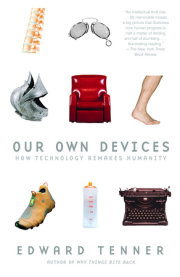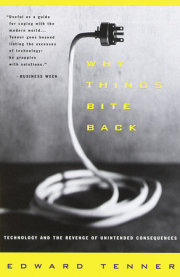Chapter One
Technology, Technique, and the Body
IN A GARY LARSON cartoon, a number of dogs are tinkering with building hardware at laboratory workbenches. The caption explains that they are striving to improve canine life by mastering the Doorknob Principle. What makes this funny is partly the idea of pooch scientists standing on their hind legs, manipulating screwdrivers and even microscopes. It recalls the long-discarded notion that we humans are the only tool-using animals. It points indirectly to the unique versatility of the human hand, with its range of grips, and the relative specialization of other creatures' paws and claws.
There is something even stranger than Larson's image, though. Other animals have a surprising ability to manipulate human technology. Not all understand what people do with things, but they develop ways to work with human-made objects, and they transmit this knowledge socially. At the dawn of industrialization, the rats of early-nineteenth-century London, with no direct auditory or visual cues, had long known that water flowed through the lead pipes servicing houses. When sufficiently thirsty, they gnawed right through them. Unfortunately, by the 1830s the pipes sometimes contained gas; the holes left by the disappointed rodents added to the risk of explosions. (Rats also loved the wax covering early matches, brought them back to their dens, and ignited the phosphorus with their teeth, causing still more fires.)
Bears in Yosemite National Park have learned to twist open screw-top jars of peanut butter, to break into food lockers with a combination of paw and snout, and to raid Dumpsters through supposedly protective slots. Bears cooperate to defeat other human technology; sow bears appear to send cubs into branches to dislodge carefully cached food, and young bears learn from observation how to break open automobile doors and penetrate the flimsy barrier separating the backseat from the food the owners thought they were protecting in the trunk. According to park rangers, who call the practice clouting, bears recognize specific brands and models, for example Honda and Toyota sedans, that are most vulnerable to attack, and use similar techniques on each model. When a particular model and color yield a rich cache of food, bears begin to attack similar vehicles every night. Mother bears show cubs how to pry open rear side doors by bending the door frame with their claws until it becomes a platform for reaching the backseat and trunk partition. Bears also brace themselves against neighboring cars to break the windows of vans more readily.
Zoo officials "never use the word can't and orangutan in the same sentence," according to the comparative psychologist Benjamin Beck, a specialist in animal survival skills. A young orangutan in the San Diego Zoo became famous for unbolting the screening of his crib, removing the wires, and moving through the zoo nursery, unscrewing lightbulbs. According to Beck, an orangutan, unlike other great apes, understands what a tool like a screwdriver means in the human world and given the opportunity could use it to take its cage apart and escape. Other orangutans have learned to distinguish the faint sounds made by electrified barrier systems and to escape when they detect that the power is off.
It should not be surprising, then, that dogs also learn the Doorknob Principle. An innocent resident of Takoma Park, Maryland, was allegedly mauled by a Prince George's County police dog in her own bed after it was sent in to look for a burglar in her basement apartment. It had gained access by turning a doorknob, which the woman has since replaced by a latch. Bizarre as these anecdotes appear, they make an important point. Those who create things, whether doorknobs or gas pipes, can only begin to imagine how they will be used. If we define technology as a modification of the environment, then we must recognize the complementary principle of technique: how that modification is used in performance. New objects change behavior, but not always as inventors and manufacturers imagine. And changes in behavior of people, as of bears and dogs, inspire new hardware, which in turn engenders more innovations.
TECHNOLOGY = TECHNIQUE?
In many European languages the same term-la technique; die Technik-describes both things and practices. One of the most incisive and influential critics of technology, Jacques Ellul, argued powerfully that modern humanity is enmeshed in such omnipresent, interlocking technological institutions that technology and technique are inseparable. Ellul begins his most important work, The Technological Society, by insisting, against Lewis Mumford, that the machine is only a result of technique, not its source. Mumford established historical periods based on energy-hydraulic, coal, electrical; Ellul sought to understand the spirit behind the power sources and machinery. For him, technology was the product of the ancient Near East; in Western antiquity and medieval Christianity, it was always subordinated to other principles. Even the Renaissance and the seventeenth century pursued humanistic universality rather than technical proficiency; many supposedly practical books of this period lose the modern reader in digression and speculation. The universal application of technique began only with the eighteenth century and the French Revolution. Mechanization was only one consequence of "systematization, unification, and clarification," equally reflected in the suppression of customary law by the Napoleonic Code. History and philosophy as we know them emerged as intellectual techniques. In fact, Ellul argues, industrialization followed rather than preceded these intellectual and cultural transformations. With the rapid industrial development of the nineteenth century-which Ellul does not attempt to explain-came a new relationship of technique to society: "a reality in itself, self-sufficient, with its own laws and determinations." Political control of technique is an illusion. It is irreversible, "beyond good and evil," not merely morally neutral but "the judge of what is moral, the creator of a new morality" and thus of "a new civilization." Humanity has become "a slug in a slot machine," setting it in motion without controlling its outcome.
Ellul's arguments are trenchant, brilliantly argued, and often persuasively illustrated. His focus on mental processes and habits as the foundations of technology is especially apt. And Ellul probably would agree that other organisms, including bears and dogs, become subject to the same technological regime. But there is strong evidence for the power of technique well before the revolutionary era. In fact, for better or worse, the dominion of technique is an ancient one. For Ellul, the Greeks simply despised technique and exalted pure theory. He cites Archimedes' destruction of the models that he used to construct his theories, once he had demonstrated his proofs geometrically. He also suggests that Greek ideals of harmony and moderation held back the development of technique. But there is no opposition between aesthetic ideals and the development of techniques. Experience and skill are hardly neglected in the Hippocratic writings in favor of abstract thought.
Ellul also underestimated the power, even "autonomy" in his terms, of military technology before the eighteenth century. Swordsmanship and other martial arts were cultivated and transmitted by generations of medieval and Renaissance masters. But only in early modern Europe did the distinction between technology and technique become apparent. Between 1594 and 1607 Maurice of Nassau, Prince of Orange, showed how technique could transform technology. Matchlock muskets were heavy and dangerous. Soldiers had to hold their weapon in one hand and a lighted fuse in the other. While some hunting weapons already had spiral grooves in their barrels for greater accuracy, this delicate rifling needed more careful loading and maintenance than rough and dirty military field conditions could afford. Thus the military musket was inaccurate as well as awkward to handle. Maurice's genius was to see that organization and synchronized motion could make the crude musket an effective weapon. Inspired by an idea of his cousin William Louis, he assigned another cousin, Maurice's adjutant Johann, to break down the cycle of preparing, loading, aiming, and firing muskets into discrete steps. Johann of Nassau had a series of forty-three plates engraved, each illustrating one stage. It was no longer enough for drillmasters to teach the operation of the musket. Soldiers now had to be able to march forward, rank on rank, as they prepared the weapons for firing when they advanced to the front rank, then countermarch to repeat the process. Only with precision and strict discipline could they avoid serious injury to themselves or their comrades. But once the process-the technique-was mastered, the troops could lay down repeated, formidable volleys. An intense field of simultaneous fire could be effective, even with many shots going wide of the mark. Maurice and Johann's manual, Weapon Handling (1607), with its elegant illustrations by Jacob de Gheyn, transformed battle throughout Europe, especially through the victories of Gustavus Adolphus of Sweden two decades later. The press was a technology, and the printer's art a technique, that accelerated the diffusion of countless others.
Here was technological synchronization three hundred years before Henry Ford. Some readers will insist that the musket itself, as a technology, somehow dictated the technique of drill. Certainly, battlefield experience determines which innovations spread and which are abandoned.
But techniques do not create themselves, and neither operators nor their supervisors initially understand the full possibilities of devices. Ellul wrote in the shadow of a modernism that still sought a single best way to do everything, and for which (as the architectural critic David Heathcote recently remarked of the British official-planning mentality of the 1960s) "design is the search for the Platonic ideal and . . . variety is symptomatic of an unsolved problem." Ellul was right to underscore the constraints of technique, but wrong to deny its creative and improvisational side. In fact the two complement each other. Just when a technique seems to have proved itself inevitable and universal, an individual may develop and spread an alternative method. Organizations and professional groups codify best practice. Gifted individuals from time to time challenge the textbooks, often failing but sometimes revising them.
TECHNIQUES OF THE BODY: MARCEL MAUSS
Ellul, like most analysts of technology, believed in a radical discontinuity between the industrial world and nonindustrial societies. An older French contemporary, the anthropologist Marcel Mauss, illuminated a side of technique that Ellul thought was too restrictive and unrelated to modern societies: the role of physical habits, which Mauss called body techniques. Ellul was correct in arguing for a concept of technique that included mental and social practices, but he ignored how important simple body techniques can be even in complex societies.
Mauss introduced the idea of body technique almost casually, in an article in a French psychology journal published in 1934. He identified a set of human practices as "effective" and "traditional," and at the same time "mechanical, physical, or physico-chemical." These were the ways people learned to do things with their bodies. These patterns of motion were
not haphazard; they were produced and inculcated by an entire society. They formed a framework of conduct. He coined the word "habitus" for these socially produced behaviors, which varied systematically "between societies, educations, proprieties and fashions, prestiges." Prestige was, for Mauss, essential to human body technique. Children imitate the actions of their elders, especially those with formal authority. The learning of body techniques is at once social, psychological, and biological. Mauss gave examples from the dances and rituals of the native peoples of Australia and New Zealand. But some of his most interesting cases are taken from the early-twentieth-century history of sports, and from his own experience.
Mauss remembered learning to swim first, then to dive. He also recalled being taught to dive with eyes shut, opening them only after immersion. By the 1930s, when his study of body techniques was published, children were expected to accustom themselves as early as possible to keeping their eyes open in the water, controlling the instinctive tendency to shut them. (The aversion to opening one's eyes in the water is now considered to be learned; swimming authorities encourage parents to begin instruction in infancy, when moving in water is still innately delightful.) Swimming, like other techniques, was an apprenticeship, but not a static one. Mauss's generation had learned to swim the breaststroke, with the head above water; by the 1930s, variations of the crawl had prevailed. No longer did swimmers swallow water and spit it as though they were "a kind of steamboat." Yet Mauss acknowledged that he still could not swim otherwise.
Walking was subject to more subtle but still discernible techniques. In the Great War, Mauss recalled, the Western Allies moved differently. The Worcester Regiment, as a token of its valor fighting beside the French infantry in the Battle of the Aisne (he probably meant that of 1914), received special permission to be accompanied by a band of French buglers and drummers. The desired panache failed. For almost half a year, "the regiment had preserved its English march but had set it to a French rhythm. . . . When they tried to march in step, the music would be out of step, with the result that the Worcester Regiment was forced to give up its French buglers." And as recently as World War II, an American observer found British troops "looser-jointed than we are, with freer knee action," and French soldiers with "a long loping swing that seems to use the shoulders to push ahead with." Were these stylized expressions of each nation's civilian steps or the choreography of long-forgotten sergeant-majors, enshrined in drill manuals?
Of course soldiers are drilled by noncommissioned officers who build morale partly by teaching these distinctive motions. Their exercises produce what William H. McNeill, in his study of dance and drill, has called "muscular bonding," the solidarity of rhythmic synchronization. Both national armies and civilians march to different drummers. Mauss began to notice that American and French women also walked differently, and that even in French society, upbringing influenced gait noticeably. Girls raised in convents, for example, walked with fists closed, and Mauss recalled his own third-form teacher "shouting at me: 'Idiot! why do you walk around the whole time with your hands flapping wide open?' " Mauss believed that many of these differences arose from physical traits. The height of Englishmen, as well as the distinctive gait they had learned from their drillmasters, made it impossible to follow the French military band. Even the goose step had a biological explanation, the German army's way of achieving the greatest possible extension of the (long) German leg, as distinct from the short, knock-kneed French limb.
Mauss was probably exaggerating the role of physical differences. Surely all European conscript armies of World War I included a significant range of heights and body types. And the goose step, officially the parade step, is only an exaggerated form of the Prussian marching style called the Gleichschritt developed in the early eighteenth century. Troops were taught to swing their legs with stiffened knees not only to build morale and cohesion but to produce an ultra-erect posture signifying and building discipline.
Copyright © 2003 by Edward Tenner. All rights reserved. No part of this excerpt may be reproduced or reprinted without permission in writing from the publisher.






